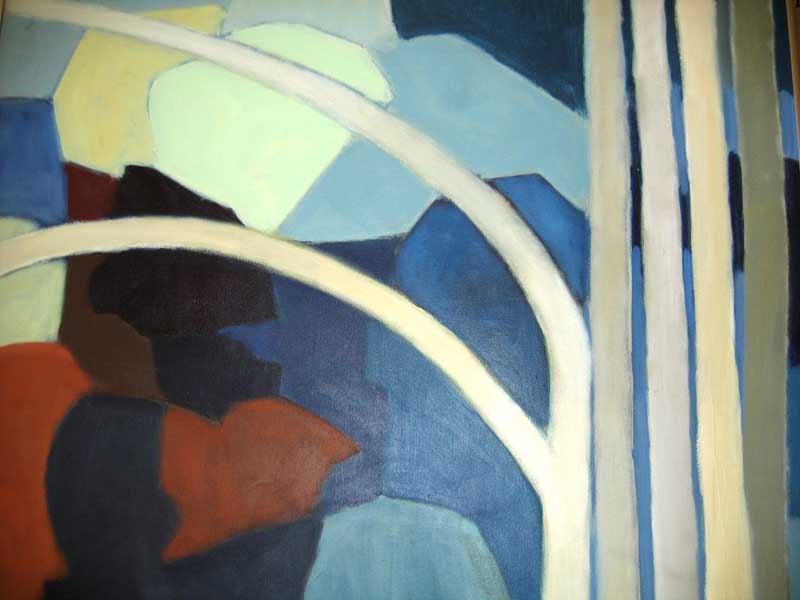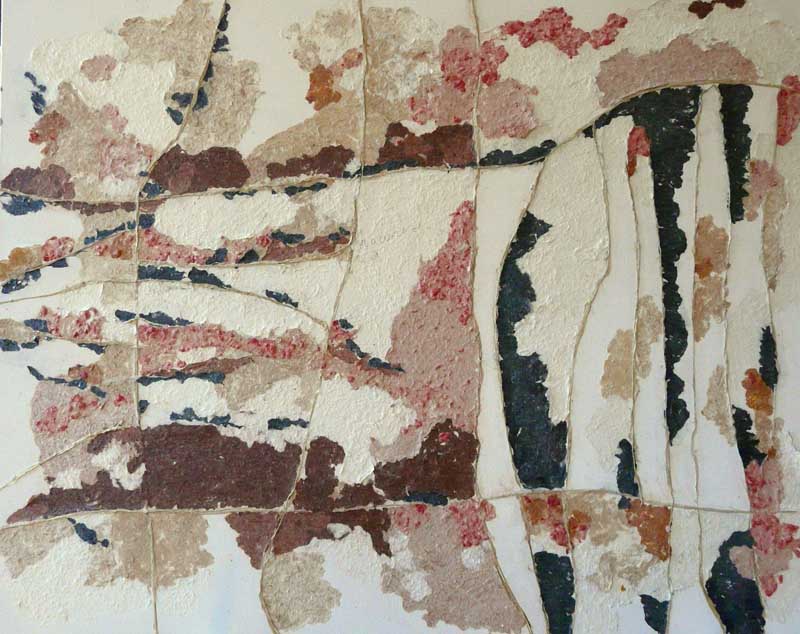Paintings
Use the following menu to skip to the selected gallery.
- 1 - Fractures
- 2 - Taïga
- 3 - Topographie secrète
- 4 - Géographie vagabonde
- 5 - Peintures Hors série
- 6 - Peintures récentes
Pictorial Space
"Painting is just another form of writing." Francine Simonin.
"Pictorial space is a wall but birds can fly freely above, below and through it." Nicolas de Staël.
Pictorial space is another territory for dreams. Here the images from nocturnal or waking dreams take the place of words. But words surface sometimes and carry their residue of meaning in calligraphy.
Artistic Methods
The space that I wished to create with the different media (sanguine, watercolours, oils, acrylics and pulp painting) reflect the direction of my artistic process. This process attempts to express a poetic and dreamlike experience.
The canvas or the pulp is first of all the starting point of a construction. I establish there the main form of the composition. The rest develops from this first vigorous form and the initial colours. This backdrop serves as a foundation for forms that spontaneously associate with it, like echoes, progressively organising the work, giving it a direction and movement.
The concrete fact of fashioning the pulp with the fingers has led me to experiment more spontaneous gestures, liberating the imagination and giving outlet to unconscious associations.
Pulp Painting
Pulp painting with fibres such as cotton, abaca, kozo, is still a little known medium. The medium permits the artist to integrate pigments and diverse materials in the wet pulp of vegetable fibres. These fibres have been prepared either by cooking or by being torn up in a machine called a hollander.
The artist can create hills and valleys in the pulp, layer thicknesses, especially with abaca fibres. Pulp dried in the open air without being put through a press, produces a paper which, depending on the will of the artist, can become a work in relief or even a three dimensional sculpture.
Gallery 1: Fractures
Click on the photos to view the gallery
The idea for « Fractures » comes from the ice storm which ravaged several regions of Quebec in 1998, leaving the horrifying, but often spectacular, debris of broken and bent trees.
The silhouettes of the trees, altered by the effect of wind and ice, took on anthropomorphic forms. Their twisted shapes transformed the landscape into gestures, evoking dance, celebration or combat. Nature, rather than carrying the stigmata of a natural disaster, seemed full of human forms.
Gallery 2: Taïga
Click on the photos to view the gallery
This series of paintings was based on photos and drawings made during trips to Labrador, Newfoundland and James Bay.
Taïga represents a voyage to the heart of the inhospitable lands of the North, the lands God gave to Cain, as Jacques Cartier described them. This theme is also paralleled in the poetry collection: Calendrier des terres froides.
In this series I try to render the austere beauty of the sparse taiga while exploring the possibilities of the new medium of pulp painting which I had just discovered. Cotton fibres lent themselves naturally to this project. In effect their coarse grain texture, retouched with acrylics, can evoke snow as well as the velvet shag of the magnificently coloured northern lichens, the miniature forest which gradually replaces the boreal pine forest.
Gallery 3: Topographie secrète
Click on the photos to view the gallery
After becoming more experienced with pulp painting, I felt the need to break away from the rectangular mould in which the artist usually pours the pulp. I started to create free form works with cotton fibres and I wanted to combine them with a canvas support. So I then glued these works on a canvas which I painted with acrylics and to which I also added kozo fibres. The painted canvas and the kozo fibres serve to integrate and prolong the movement already present in the free form cotton works.
The paintings thus created, evoke in their rhythm and form the lie of the land that is most familiar to me : the landscapes of Gatineau park.
Gallery 4: Géographie vagabonde
Click on the photos to view the gallery
I eventually exchanged the cotton fibres for abaca. In drying, the abaca pulp rises and produces a fine, but very strong, raised relief surface. Its texture and colour bring to mind the parchment used in old geographical maps. So the theme of geography, the terrestrial space, naturally inscribed itself in these works.
This is a series of “vagabond” geography as one might say “vagabond imagination” for I create humorous and fantastic maps of our planet. The dream-like cartography that I propose aims to describe imaginary places, or places having only a name to connect them with reality. I consign them to an atlas of the imagination like real territories occupying the planet.
Gallery 5: Peintures hors-série
Acrylic on canvas
Click on the photos to view the gallery
Gallery 6: Peintures récentes
Click on the photos to view the gallery
Texts & content: Claire Boulé © All rights reserved.
Conception: Gorman Productions, 2018



























































